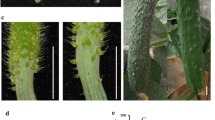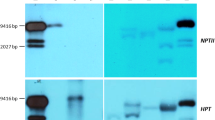Abstract
Key message
An unusual flower and tendril (uft) mutant in cucumber was caused by a mutation in Csa1G056950 encoding an F-box protein.
Abstract
Flowers and tendrils are important agronomic and yield traits of cucumber (Cucumis sativus L.). In this study, we identified an unusual flower and tendril (uft) mutant from an ethyl methanesulfonate (EMS) mutagenesis population. Genetic analysis revealed that the phenotype of the uft mutant was regulated by a single recessive nuclear gene. Map-based cloning and MutMap+ results demonstrated that Csa1G056950 (CsUFO), encoding an F-box protein, was the causal gene for the uft mutant phenotype of cucumber. A single nucleotide polymorphism (SNP) mutation (C to T) in the second exon of CsUFO resulted in premature translation termination. The expression level of CsUFO was significantly decreased in apical buds of the uft mutant compared with the wild-type (WT) WD1. Transcriptome analysis indicated that many genes for organ development were down-regulated in uft plants, suggesting CsUFO-associated networks that regulate flower and tendril development. These findings provide a new insight into understanding the molecular mechanisms of flower organogenesis in cucumber.



Similar content being viewed by others
Data availability
The data that support the findings of this study are available from the corresponding author upon reasonable request.
References
Alexa A, Rahnenführer J (2009) Gene set enrichment analysis with topGO. Bioconductor 27:1–26
Alexa A, Rahnenfuhrer J (2010) topGO: enrichment analysis for gene ontology. R package version 2
Alvarez-Buylla ER, Benitez M, Corvera-Poire A, Chaos Cador A, de Folter S, Gamboa de Buen A, Garay-Arroyo A, Garcia-Ponce B, Jaimes-Miranda F, Perez-Ruiz RV, Pineyro-Nelson A, Sanchez-Corrales YE (2010) Flower development Arabidopsis. Book 8:e0127
Bell AD, Bryan A (2008) Plant form: an illustrated guide to flowering plant morphology. Timber Press, Portland
Blazquez MA, Soowal LN, Lee I, Weigel D (1997) LEAFY expression and flower initiation in Arabidopsis. Development 124:3835–3844
Boss PK, Thomas MR (2002) Association of dwarfism and floral induction with a grape ‘green revolution’mutation. Nature 416:847–850
Bowman JL, Smyth DR, Meyerowitz EM (1989) Genes directing flower development in Arabidopsis. Plant Cell 1:37–52
Bowman JL, Smyth DR, Meyerowitz EM (1991) Genetic interactions among floral homeotic genes of Arabidopsis. Development 112:1–20
Busch MA, Bomblies K, Weigel D (1999) Activation of a Floral Homeotic Gene in Arabidopsis. Science 285:585–587
Chae E, Tan QK, Hill TA, Irish VF (2008) An Arabidopsis F-box protein acts as a transcriptional co-factor to regulate floral development. Development 135:1235–1245
Chen H, Sun J, Li S, Cui Q, Zhang H, Xin F, Wang H, Lin T, Gao D, Wang S, Li X, Wang D, Zhang Z, Xu Z, Huang S (2016) An ACC oxidase gene essential for cucumber carpel development. Mol Plant 9:1315–1327
Chen F, Fu B, Pan Y, Zhang C, Wen H, Weng Y, Chen P, Li Y (2017) Fine mapping identifies CsGCN5 encoding a histone acetyltransferase as putative candidate gene for tendril-less1 mutation (td-1) in cucumber. Theor Appl Genet 130:1–10
Craig KL, Tyers M (1999) The F-box: a new motif for ubiquitin dependent proteolysis in cell cycle regulation and signal transduction. Progress Biophys Mol Biol 72:299–328
Durfee T, Roe JL, Sessions RA, Inouye C, Serikawa K, Feldmann KA, Weigel D, Zambryski PC (2003) The F-box-containing protein UFO and AGAMOUS participate in antagonistic pathways governing early petal development in Arabidopsis. Proc Natl Acad Sci 100:8571–8576
Fulton TM, Chunwongse J, Tanksley SD (1995) Microprep protocol for extraction of DNA from tomato and other herbaceous plants. Plant Mol Biol Rep 13:207–209
Gourlay CW, Hofer JM, Ellis TN (2000) Pea compound leaf architecture is regulated by interactions among the genes UNIFOLIATA, COCHLEATA, AFILA, and TENDRIL-LESS. Plant Cell 12:1279–1294
Ha CM, Jun JH, Fletcher JC (2010) BLADE-ON-PETIOLE1 and 2 control Arabidopsis leaf morphogenesis by regulating YABBY and KNOX gene activity. Genetics 186:197–206
Hofer J, Turner L, Moreau C, Ambrose M, Isaac P, Butcher S, Weller J, Dupin A, Dalmais M, Le Signor C (2009) Tendril-less regulates tendril formation in pea leaves. Plant Cell 21:420–428
Huala E, Sussex IM (1992) LEAFY interacts with floral homeotic genes to regulate Arabidopsis floral development. Plant Cell 4:901–913
Isnard S, Silk WK (2009) Moving with climbing plants from Charles Darwin’s time into the 21st century. Am J Bot 96:1205–1221
Jaffe M, Galston A (1968) The physiology of tendrils. Ann Rev Plant Physiol 19:417–434
Krizek BA, Fletcher JC (2005) Molecular mechanisms of flower development: an armchair guide. Nat Rev Genet 6:688–698
Kumar S, Stecher G, Li M, Knyaz C, Tamura K (2018) MEGA X: molecular evolutionary genetics analysis across computing platforms. Mol Biol Evol 35:1547–1549
Lamb RS, Hill TA, Tan QK-G, Irish VF (2002) Regulation of APETALA3 floral homeotic gene expression by meristem identity genes. Development 129:2079–2086
Lee I, Wolfe DS, Nilsson O, Weigel D (1997) A LEAFY co-regulator encoded by UNUSUAL FLORAL ORGANS. Curr Biol 7:95–104
Levin JZ, Meyerowitz EM (1995) UFO: an Arabidopsis gene involved in both floral meristem and floral organ development. Plant Cell 7:529–548
Li Z, Wang S, Tao Q, Pan J, Si L, Gong Z, Cai R (2012) A putative positive feedback regulation mechanism in CsACS2 expression suggests a modified model for sex determination in cucumber (Cucumis sativus L.). J Exp Bot 63:4475–4484
Livak KJ, Schmittgen TD (2001) Analysis of relative gene expression data using real-time quantitative PCR and the 2−ΔΔCT method. Methods 25:402–408
Loy B (2012) A recessive tendrilless mutant in ornamental pumpkin. Cucurbit Genet Coop Rpt 35–36:31–32
Malepszy S, Niemirowicz-Szczytt K (1991) Sex determination in cucumber (Cucumis sativus) as a model system for molecular biology. Plant Sci 80:39–47
Mizuno S, Sonoda M, Tamura Y, Nishino E, Suzuki H, Sato T, Oizumi T (2015) Chiba Tendril-Less locus determines tendril organ identity in melon (Cucumis melo L.) and potentially encodes a tendril-specific TCP homolog. J Plant Res 128:941–951
Neff MM, Turk E, Kalishman M (2002) Web-based primer design for single nucleotide polymorphism analysis. Trends Genet 18:613–615
Risseeuw E, Venglat P, Xiang D, Komendant K, Daskalchuk T, Babic V, Crosby W, Datla R (2013) An activated form of UFO alters leaf development and produces ectopic floral and inflorescence meristems. PLoS ONE 8:e83807
Sasaki K, Yamaguchi H, Aida R, Shikata M, Abe T, Ohtsubo N (2012) Mutation in Torenia fournieri Lind. UFO homolog confers loss of TfLFY interaction and results in a petal to sepal transformation. Plant J 71:1002–1014
Schöb H, Kunz C, Meins F Jr (1997) Silencing of transgenes introduced into leaves by agroinfiltration: a simple, rapid method for investigating sequence requirements for gene silencing. Mol Gener Genet MGG 256:581–585
Soltis DE, Chanderbali AS, Kim S, Buzgo M, Soltis PS (2007) The ABC model and its applicability to basal angiosperms. Ann Bot 100:155–163
Tadmor Y, Katzir N, Meir A, Yaniv-Yaakov A, Sa’Ar U, Baumkoler F, Lavee T, Lewinsohn E, Schaffer A, Burger J (2007) Induced mutagenesis to augment the natural genetic variability of melon (Cucumis melo L.). Israel J Plant Sci 55:159–169
Takagi H, Abe A, Yoshida K, Kosugi S, Natsume S, Mitsuoka C, Uemura A, Utsushi H, Tamiru M, Takuno S, Innan H, Cano LM, Kamoun S, Terauchi R (2013) QTL-seq: rapid mapping of quantitative trait loci in rice by whole genome resequencing of DNA from two bulked populations. Plant J 74:174–183
Taylor S, Hofer J, Murfet I (2001) Stamina pistilloida, the pea ortholog of Fim and UFO, is required for normal development of flowers, inflorescences, and leaves. Plant Cell 13:31–46
Van Ooijen J (2006) JoinMap® 4. Software for the calculation of genetic linkage maps in experimental populations, Kyazma BV, Wageningen, p 33
Wang X, Feng S, Nakayama N, Crosby WL, Irish V, Deng XW, Wei N (2003) The COP9 signalosome interacts with SCFUFO and participates in Arabidopsis flower development. Plant Cell 15:1071–1082
Wang S, Yang X, Xu M, Lin X, Lin T, Qi J, Shao G (2015) A rare SNP identified a TCP transcription factor essential for tendril development in cucumber. Mol Plant 8:1795–1808
Winter CM, Austin RS, Blanvillain-Baufume S, Reback MA, Monniaux M, Wu M-F, Sang Y, Yamaguchi A, Yamaguchi N, Parker JE (2011) LEAFY target genes reveal floral regulatory logic, cis motifs, and a link to biotic stimulus response. Dev Cell 20:430–443
Zhang W, Pan J, He H, Zhang C, Li Z, Zhao J, Yuan X, Zhu L, Huang S, Cai R (2012) Construction of a high density integrated genetic map for cucumber (Cucumis sativus L.). Theor Appl Genet 124:249–259
Zhao D, Yang M, Solava J, Ma H (1999) The ASK1 gene regulates development and interacts with the UFO gene to control floral organ identity in Arabidopsis. Dev Genet 25:209–223
Zhao W, Chen Z, Liu X, Che G, Gu R, Zhao J, Wang Z, Hou Y, Zhang X (2018) CsLFY is required for shoot meristem maintenance via interaction with WUSCHEL in cucumber (Cucumis sativus). New Phytol 218:344–356
Zhu P, He L, Li Y, Huang W, Xi F, Lin L, Zhi Q, Zhang W, Tang YT, Geng C, Lu Z, Xu X (2014) OTG-snpcaller: an optimized pipeline based on TMAP and GATK for SNP calling from ion torrent data. PLoS ONE 9:e97507
Zhuang LL, Ambrose M, Rameau C, Weng L, Yang J, Hu XH, Luo D, Li X (2012) LATHYROIDES, Encoding a WUSCHEL-related homeobox1 transcription factor, controls organ lateral growth, and regulates tendril and dorsal petal identities in garden pea (Pisum sativum L.). Mol Plant 5:1333–1345
Acknowledgements
We thank Dr. Pengbo Xu (Shanghai Jiao Tong University) for technical assistance in the experiment. This study was supported by the Shanghai Agriculture Applied Technology Development Program (2020-02-08-00-08-F0148), the Project of Science and Technology Commission of Shanghai Municipality (18391900300), the National Natural Science Foundation of China (31972425), and the Agri-X Interdisciplinary Fund of Shanghai Jiao Tong University (Agri-X2017011).
Author information
Authors and Affiliations
Contributions
YC performed the experiments and prepared the manuscript. HW, JP and HD participated in the experiments. KZ, LZ and YY contributed to the writing of this paper. HH, RC and GW provided materials. JP and GW, the corresponding authors, supervised entire experimental process. All authors have read and approved the manuscript.
Corresponding authors
Ethics declarations
Conflict of interest
The authors declare that they have no conflicts of interest.
Additional information
Communicated by Amnon Levi.
Publisher's Note
Springer Nature remains neutral with regard to jurisdictional claims in published maps and institutional affiliations.
Supplementary information
Below is the link to the electronic supplementary material.
Rights and permissions
About this article
Cite this article
Chen, Y., Wen, H., Pan, J. et al. CsUFO is involved in the formation of flowers and tendrils in cucumber. Theor Appl Genet 134, 2141–2150 (2021). https://doi.org/10.1007/s00122-021-03811-4
Received:
Accepted:
Published:
Issue Date:
DOI: https://doi.org/10.1007/s00122-021-03811-4




